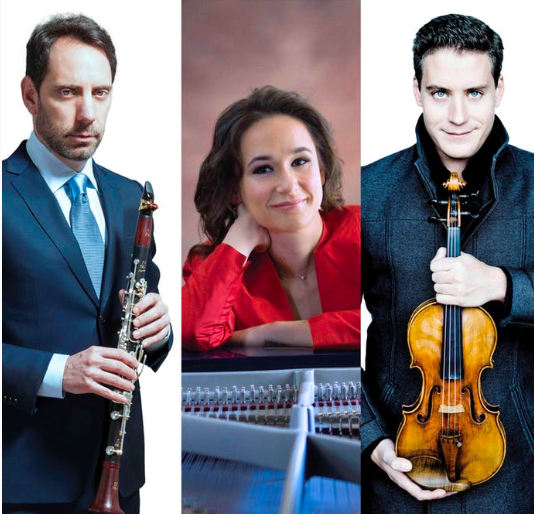Kristóf Baráti, Violin; Bence Szepesi, Clarinet; Éva Polgár, Piano
Zankel Hall at Carnegie Hall, New York, NY
Sunday, November 24, 2019
Sunday November 24th was quite a day for the clarinet in New York, as this musician found herself assigned to review two excellent clarinet concerts within hours of each other. The first concert of the afternoon, at Zankel Hall, was actually a chamber program featuring Hungarian clarinetist Bence Szepesi, whom I had had the pleasure of hearing and reviewing favorably for New York Concert Review last September, as he kicked off a year of touring with a Weill Hall recital (Bence Szepesi in Review). Mr. Szepesi’s Zankel appearance Sunday marked the end of his touring year with a program of Khachaturian, Schumann, Brahms, and Bartók, duos and trios that corralled the talents of two compatriots, violinist Kristóf Baráti and pianist Éva Polgár. All three have fine credentials, awards, international performances, and recordings, and under the aegis of the AGP Agency they gave us a remarkable afternoon of music.
Starting with strength is usually a good idea, and this trio did just that with the Trio in G minor for Clarinet, Violin, and Piano (1932), an early masterpiece of Aram Khachaturian. One simply doesn’t hear this trio every day, so it was a treat to reacquaint oneself with it in the capable hands of these three musicians. They showed a strong affinity for its emotional power and seemed to revel in the exotic atmosphere and winding ornamented phrases that reflect the composer’s own Armenia, along with Uzbek and other folk influences.
Mr. Szepesi sustained his long, luscious lines with effortless fluidity, as one could expect from the last recital, but the pleasant surprise here was the violinist Mr. Baráti, whom this listener had never heard, despite his very active performing life. Mr. Baráti’s tone has a sweetness that surely owes a partial debt to his very special instrument, the 1703 “Lady Harmsworth” Stradivarius (an instrument so inspiring to him that he in fact named his 2016 disc of encores “The Soul of Lady Harmsworth”). No violin plays itself, of course, and Mr. Baráti showed musicianly instincts at every turn. He and Mr. Szepesi melded beautifully, and the Khachaturian, with its intertwining lines was the perfect match for them. Ms. Polgár was exemplary in her handling of the piano part. She established a hypnotic tone for the first movement, maintained a solid framework for the highly rhapsodic writing, was precise in what were sometimes torrents of passagework, and skillfully effected decisive tempo changes for the three (as in the last movement). One could hardly imagine performers better suited to this work than these three.
Following the Khachaturian came Schumann, his Drei Fantasiestücke (Op. 73), for clarinet and piano. These were well performed overall, though this listener sensed that the comfort level was not as great here as in the Khachaturian. From the opening, which Schumann marks Zart und mit Ausdruck (Tender and with expression), the measured tempo seemed to convey reticence rather than intimacy. Such reactions are of course personal, but one wondered whether the duo of Polgár and Szepesi had yet reached a true meeting of the minds. The second piece, Lebhaft, leicht (Lively, light) achieved just the right breeziness – with the pianist even approximating a reedy sound herself – but the third piece, Rasch und mit Feuer (Quick and with fire) found doubts returning. What one usually thinks of as impulsiveness in this movement verged on skittishness here, and sure enough (as technical ease does often match interpretive decisiveness) there were glitches. All ended with brio, though, even if – to this listener – the final moments had a bit too much dispatch and almost a Mozartean lightness.
This listener, though always hoping to enjoy all performances, was braced to dislike the next work on the program, as one read that it was to be a clarinet-piano arrangement (by Bence Szepesi) of the eternally loved Intermezzo in A major, Op. 118, No. 2 for piano by Brahms, a work that stands in perfection with no adornment or adaptation; to my great surprise, however, I enjoyed it thoroughly. Mr. Szepesi’s arrangement showed good fidelity to the score, with the added virtue that all of Brahms’s singing phrases had the penetrating and sustained sound for which pianists strive. The duo played it with great sensitivity. Ms. Polgár gets kudos for the restraint needed to play such arrangements without diving into the original – she supported the clarinet in perfect balance.
A strong finish was in store at this point, as the trio took on Bartók’s exciting Contrasts for Violin, Clarinet, and Piano (1938-40). The three gave it an energetic ride, each player making child’s play out of the wild ranges, runs, cadenzas, and brilliant passagework. The first movement, Verbunkos (Recruiting Dance), found Mr. Szepesi in especially fine form with its virtuoso demands. The second movement, Pihenő (strangely: Relaxation) found all three united in a conception of mysterious simmering, as the music invites with its eerie trills and sense foreboding. The third and final movement Sebes (Fast Dance) was stunningly played by all three in impressive synchronization through lightning fast runs and imitative patterns. Mr. Baráti’s technique was stellar in the cadenza.
The Contrasts are always a revelation to hear, with many jazzy elements, including an opening movement that Bartók himself admitted owes a debt to the Blues movement of Ravel’s Sonata No. 2. Its history is fascinating as well. It was composed in response to a letter from the great Hungarian violinist Joseph Szigeti, though ultimately commissioned by legendary clarinetist Benny Goodman. Goodman and Szigeti gave it the premiere with Bartók at the piano in Carnegie Hall in 1940 (before there was a Zankel Hall), As one listened to this Sunday’s trio (which perhaps deserves a name if they wish to continue as a group), one couldn’t help thinking that they should give the work a repeat performance on its 80th anniversary in 2020. Bravi tutti!


